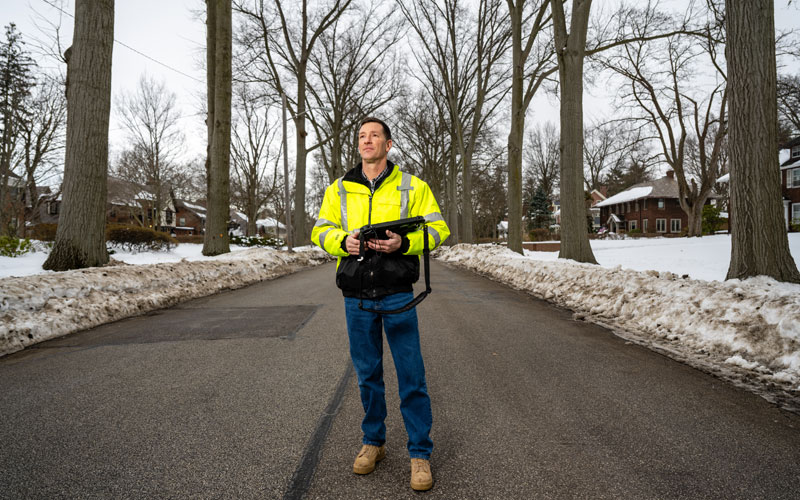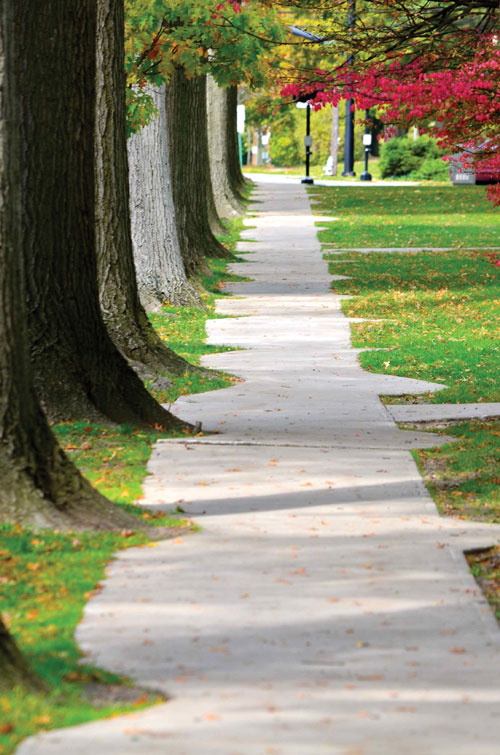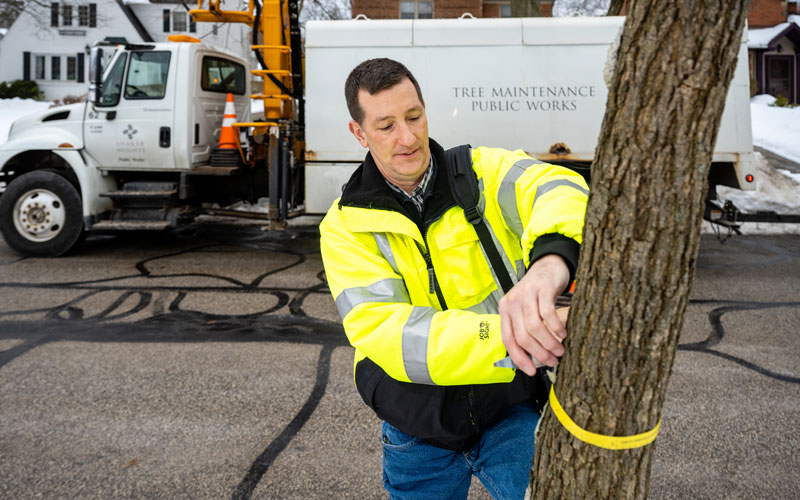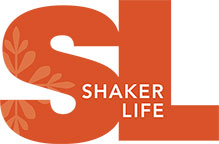The City’s new Street Tree Master Plan is based on the science of growing healthy trees in an urban environment.
By Diana Simeon

Charles Orlowski, the City’s forester and a certified arborist. Photo by Jason Miller.
The tree-lined streets of Shaker Heights are not just beautiful, they’re a vital environmental asset. The City’s street trees — estimated to number around 30,000 — make up a substantial portion of the community’s tree canopy. They cool our neighborhoods, help reduce stormwater run-off, improve our air quality, and so much more.
But growing street trees in an urban setting like Shaker Heights is not easy. The City’s tree lawns are narrow, packed with infrastructure (both underground and overhead) and often on busy roadways. A changing climate isn’t helping.
“Preserving and maintaining our urban forest has a number of challenges,” says Shaker Heights City Council Member Nancy Moore, who chairs the City’s Tree Advisory Board. “In fact, the conditions for growing street trees are increasingly hostile, thanks to a warming environment and encroaching infrastructure.”
In 2021, the Tree Advisory Board spearheaded the development of a new Street Tree Master Plan for Shaker Heights, in collaboration with the City’s Forestry Department. The goal: To create a roadmap for the City’s street tree program, based on decades of research by the Ohio Department of Natural Resources (ODNR), which will ensure the community’s tree canopy remains vibrant for generations to come.
“This is a strategic plan for the City’s urban forest,” explains Moore. “The emphasis is on the science of planting and maintaining trees in an urban environment.”
Planting the Right Trees

Photos by Karoline Pimplikar
The Street Tree Master Plan has two main areas of focus: (1) the kinds of trees the City plants and where they’re planted and (2) implementing a systematic and customizable approach to maintenance that ensures every street tree gets the care it requires.
Data will help drive decision making. For example, planting decisions will be determined using the ODNR Division of Forestry’s Urban Site Index.
“The Urban Site Index is based on decades of research by the state’s foresters about what works best in what site conditions,” explains Charles Orlowski, the City’s forester and a certified arborist.
More specifically, the Urban Site Index allows foresters, like Orlowski, to input a variety of data for a planting site to determine the best tree selection for the planting conditions and available planting space.
“Not every tree is right for every location in an urban environment,” says Orlowski. “For example, a Red Oak is not going to fare well on Chagrin Boulevard. The soil is too compacted, the rock salt used during the winter is too heavy, and the tree lawn too narrow. So, the Urban Site Index will really help us identify what trees will work best on what streets in our City.”
Growing Healthy Trees
Planting the right tree in the right spot is just the first step in sustaining and improving the City’s urban forest. Also important: ensuring the City’s street trees receive the maintenance they require to grow well.
“You need to prune trees every five years or so to have them grow more healthily,” says Orlowski.
In general, younger trees need training – a type of pruning to encourage healthy growth – whereas older trees need maintenance pruning (removing dead or hazardous branches, for example). The Street Tree Master Plan calls for the City’s street trees to be pruned on a five-year cycle.
“Not every tree is right for every location in an urban environment.”
Like planting, the City’s approach to maintenance will also be data- driven. Specifically, the City’s Forestry Department will undertake a Street Tree Inventory to create a database of information about every street tree in the City. This Inventory is expected to take about five years to complete.
“We will identify the tree, its location — including site conditions and nearby utilities, like gas and sewer lines — the diameter, what kind of maintenance is required for the tree, and other information,” says Orlowski, who estimates there are “easily” upwards of 30,000 street trees in Shaker Heights.
“As a result, we’ll be able to provide detailed guidance for our forestry crews before they start work on a street. We will be able to determine what’s needed for specific trees on any street in Shaker Heights.”
In addition, the database will allow the City to further improve its planting and maintenance decisions by allowing the Forestry Department to track how certain trees perform in certain locations over time. It will also help Orlowski ensure that a diversity of tree species line Shaker’s roadways.
“If we know the tree lawns on both sides of a planting site have maples, then we might drop in an oak or a tulip tree,” says Orlowski, who notes that planting a single type of tree on an entire street is a practice from a bygone era.
“Back when they were building Shaker Heights, they planted elm trees everywhere. They were a nice hardy tree and created a beautiful canopy, but then Dutch Elm disease came along and decimated entire neighborhoods. By diversifying our trees, if a pest or disease comes along – like Oak Wilt – we only lose sporadic trees, not an entire street of trees,” he says.

Photo by Jason Miller
Focus on Natives
Over the past several years, the City has worked to become a more sustainable community. For the Forestry Department, this has included a decision to move away from planting non-native tree species.
“We have a warming climate with increasingly severe storms,” says Moore. “So we need tree species that have a better chance of survival given those conditions and we know that native species are the answer.”
In addition, native trees provide other environmental benefits, like habitat for Northeast Ohio’s wildlife, including pollinators. Plus, they don’t tend to become invasive, like some non-native species.
Both Orlowski and Moore stress that implementing the Street Tree Master Plan will take time.
“We wanted a plan that stated where we want to go, not where we are today,” explains Moore. “We hope our community will understand that this is a roadmap for the future of this critical subset of City-owned and -managed trees in our urban forest.”



